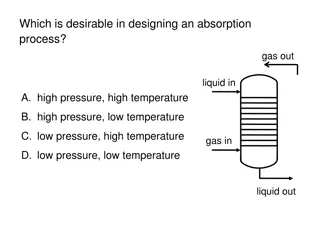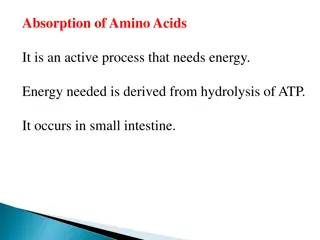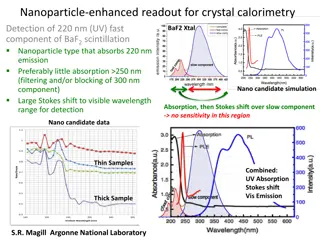
Biopharmaceutics and Drug Absorption: Understanding Drug Performance
In biopharmaceutics, the physicochemical properties, dosage form, and route of drug administration play a crucial role in achieving desired therapeutic outcomes. This field explores the interplay between drug characteristics and patient response, focusing on drug absorption, distribution, and pharmacologic effects.
Download Presentation

Please find below an Image/Link to download the presentation.
The content on the website is provided AS IS for your information and personal use only. It may not be sold, licensed, or shared on other websites without obtaining consent from the author. If you encounter any issues during the download, it is possible that the publisher has removed the file from their server.
You are allowed to download the files provided on this website for personal or commercial use, subject to the condition that they are used lawfully. All files are the property of their respective owners.
The content on the website is provided AS IS for your information and personal use only. It may not be sold, licensed, or shared on other websites without obtaining consent from the author.
E N D
Presentation Transcript
Biopharmaceutics Ali K. Alobaidy
Reference text Shargel L., Yu AB Applied Biopharmaceutics and Pharmacokinetics
Introduction The physicochemical pharmaceutical ingredient, the dosage form of the drug, and the route of administration are critical determinants of the in-vivo performance, safety and efficacy of the drug product. characteristics of the active The properties of the drug and its dosage form are carefully engineered and tested to produce a stable drug product that upon administration provides the desired therapeutic response in the patient. Both the pharmacist and the pharmaceutical scientist must understand these comprehend the proper pharmaceuticals. complex use relationships development to of and
To illustrate the importance of the drug substance and the drug formulation on absorption, and distribution of the drug to the site of action, one must first consider the sequence of events that precede elicitation of a drug's therapeutic effect. 1- First, the drug in its dosage form is taken by the patient either by an oral, intravenous, transdermal, or by other route of administration. 2- Next, the drug is released from the dosage form in a predictable and characterizable manner. 3- Then, some fraction of the drug is absorbed from the site of administration into either the surrounding tissue, into the body (as with oral dosage forms), or both. 4- Finally, the drug reaches the site of action. subcutaneous,
If the drug concentration at the site of action exceeds the minimum effective pharmacologic response results. concentration (MEC), a Biopharmaceutics is the science that examines the interrelationship of the physicochemical properties of the drug, the dosage form in which the drug is given, and the route of administration on the rate and extent of systemic drug absorption. Biopharmaceutics involves factors that influence (1) the stability of the drug within the drug product, (2) the release of the drug from the drug product, (3) the rate of dissolution/release of the drug at the absorption site, and (4) the systemic absorption of the drug. A general scheme describing this described in fig.1 . dynamic relationship is
Drug in systemic circulation Drug in Tissues Absorption Drug release and dissolution Elimination Excretion and metabolism Pharmacologic Or Clinical effect Figure1-1 Scheme demonstrating the dynamic relationship between the drug, the drug product, and the pharmacologic effect.
The fundamental scientific principles and experimental methodology. study of biopharmaceutics is based on Studies in biopharmaceutics use both in-vitro and in-vivo methods. In-vitro methods are procedures employing test apparatus and equipment laboratory animals or humans. In-vivo methods are more complex studies involving human subjects or laboratory animals. without involving
Pharmacokinetics After a drug is released from its dosage form, the drug is absorbed into the surrounding tissue, the body, or both. The distribution through and elimination of the drug in the body varies for each patient but can be characterized using mathematical models and statistics. Pharmacokinetics is the science of the kinetics of drug absorption, distribution, and elimination (ie, excretion and metabolism). The description of drug distribution and elimination is often termed as drug disposition. Characterization of drug disposition is an important prerequisite for determination or modification of dosing regimens for individuals and groups of patients.
intra- and interindividual variations will frequently result in either a subtherapeutic (drug concentration below the minimum effective concentration, MEC) or toxic response (drug concentrations minimum toxic concentration, MTC), which may then require adjustment to the dosing regimen. above the Clinical pharmacokinetic methods to drug therapy. Clinical pharmacokinetics involves approach to individually optimized dosing strategies based on the patient's disease state and patient- specific considerations. pharmacokinetics is the application of a multidisciplinary
Pharmacodynamics Pharmacodynamics between the drug concentration at the site of action (receptor) and pharmacologic response, including biochemical and physiologic effects that influence the interaction of drug with the receptor. refers to the relationship The interaction of a drug molecule with a receptor causes the initiation of a sequence of molecular events resulting in a pharmacologic response. or toxic
Measurement of drug concentrations Because drug concentrations are an important element in determining individual or population pharmacokinetics, drug measured in biologic samples, such as milk, saliva, plasma, and urine. Sensitive, accurate, and methods are available for the direct measurement of drugs in biologic matrices. In general, chromatographic methods are most frequently employed measurement, because chromatography separates the drug from other related materials that may cause assay interference. concentrations are precise analytical for drug concentration
Sampling of Biologic Specimens Invasive methods include sampling blood, spinal fluid, synovial fluid, tissue biopsy, or any biologic material that requires parenteral or surgical patient. noninvasive methods include sampling of urine, saliva, feces, expired air, or any biologic material that can be obtained without parenteral or surgical intervention. The measurement of concentration in each of these biologic materials yields important information, such as 1- the amount of drug retained in, or transported into, that region of the tissue or fluid, 2- the likely pharmacologic or toxicological outcome of drug dosing, and drug metabolite formation or transport. intervention in the drug and metabolite
Drug Concentrations in Blood, Plasma, or Serum Measurement of drug concentration in the blood, serum, or plasma is the most direct approach to assessing the pharmacokinetics of the drug in the body. Whole blood contains cellular elements including red blood cells, white blood cells, platelets, and various other proteins, globulins. In general, serum or plasma is most commonly used for drug measurement. such as albumin and
Plasma perfuse all the tissues of the body, including the cellular elements in the blood. Assuming that a drug in the plasma is in dynamic equilibrium with the tissues, then changes in the drug concentration in plasma will reflect changes in tissue drug concentrations.
Differences between plasma and serum 1. Plasma is the part of the blood that contains both the serum and clotting factors. 2. Serum is the part of the blood that remains once the clotting factors like fibrin have been removed. 3. Plasma contains the clotting factors and water, while serum contains proteins like albumin and globulins.
Plasma Level-Time Curve The plasma level time curve is generated by obtaining the drug concentration in plasma samples taken at various time intervals after administered. As the drug reaches the general (systemic) circulation, plasma drug concentrations will rise up to a maximum. Usually, absorption of a drug is more rapid than elimination. As the drug is being absorbed into the systemic circulation, the drug is distributed to all the tissues in the body and is also simultaneously being eliminated. Elimination of a drug can proceed by excretion, biotransformation, or a combination of both. a drug product is
The relationship of the drug leveltime curve and various pharmacologic parameters for the drug is shown in the next Fig. . MEC and MTC represent concentration and minimum toxic concentration of drug, respectively. the minimum effective Assuming the drug concentration in the plasma is in equilibrium with the tissues, minimum concentration receptors to produce the desired pharmacologic effect. the drug MEC needed reflects the the of at Similarly, the MTC represents the drug concentration needed to just barely produce a toxic effect.
The onset time corresponds to the time required for the drug to reach the MEC. The intensity of the pharmacologic effect is proportional to the number of drug receptors occupied, which is reflected in the observation that higher plasma drug concentrations produce response, up to a maximum. a greater pharmacologic The duration of drug action is the difference between the onset time and the time for the drug to decline back to the MEC.
Generalized plasma level-time curve after oral administration of a drug
In contrast, the pharmacokineticist can also describe the plasma level time pharmacokinetic terms as peak plasma level, time for peak plasma level, and area under the curve(AUC) . The time of peak plasma level is the time of maximum drug concentration in the plasma and is a rough marker of average rate of drug absorption. The peak plasma level concentration is related to the dose, the rate constant for absorption, and the elimination constant of the drug. The AUC is related to the amount of drug absorbed systemically. curve in terms of such or maximum drug
Plasma level-time curve showing peak time and concentration. The shaded portion represents the AUC (area under the curve)
Drug Concentrations in Tissues Tissue biopsies are diagnostic purposes, such as the verification of a malignancy. Usually, only a small sample of tissue is removed, making drug concentration measurement difficult. Drug concentrations in tissue biopsies may not reflect drug concentration in other tissues nor the drug concentration in all parts of the tissue from which the biopsy material was removed. For example, if the tissue biopsy was for the diagnosis of a tumor within the tissue, the blood flow to the tumor cells may not be the same as the blood flow to other cells in this tissue. occasionally removed for
Drug concentration in urine and feces Measurement of drug in urine is an indirect method to ascertain the bioavailability of a drug. The rate and extent of drug excreted in the urine reflects the rate and extent of systemic drug absorption. Measurement of drug in feces may reflect drug that has not been absorbed after an oral dose or may reflect drug that has been expelled by biliary secretion after systemic absorption.
Drug concentration in saliva Saliva drug concentrations have been reviewed for many drugs (for therapeutic drug monitoring ). Because only free drug diffuses into the saliva, saliva drug levels tend to approximate free drug rather than total plasma drug concentration. The use of salivary drug concentrations as a therapeutic indicator should be used with caution and preferably as a secondary indicator.
Significance of Measuring Plasma Drug Concentrations The intensity of the pharmacologic or toxic effect of a drug is often related to the concentration of the drug at the receptor site, usually located in the tissue cells. Because most of the tissue cells are richly perfused with tissue fluids or plasma, measuring the plasma drug level is a responsive method of monitoring the course of therapy. Monitoring the concentration of drugs in the blood or plasma ascertains that the calculated dose actually delivers the plasma level required for therapeutic effect.
Clinically, individual variations in the pharmacokinetics of drugs are quite common. With some drugs, receptor expression and/or sensitivity in individuals varies, so monitoring of plasma levels is needed to distinguish the patient who is receiving too much of a drug from the patient who is supersensitive to the drug. Moreover, the patient's physiologic functions may be affected by disease, concurrent drug therapy, and other factors. Pharmacokinetic models interpretation of the relationship between plasma drug levels and pharmacologic response. nutrition, environment, allow more accurate
In many cases, the pharmacodynamic response to the drug may be more important to measure than just the plasma drug concentration. diabetic patients taking insulin will monitor their own blood or urine glucose levels. For drugs that act irreversibly at the receptor site, plasma drug concentrations predict pharmacodynamic response. Drugs used in cancer chemotherapy often interfere with nucleic acid or protein biosynthesis to destroy tumor cells. For these drugs, the plasma drug concentration does not relate directly to the pharmacodynamic response. In this case, other pathophysiologic parameters and side effects are monitored in the patient to prevent adverse toxicity. For example: most may not accurately
Basic Pharmacokinetics and Pharmacokinetic Models A model is a hypothesis using mathematical terms to describe quantitative relationships concisely. The predictive capability of a model lies in the proper selection and development of mathematical function(s) that parameterize the essential factors governing the kinetic process. The key parameters in a process are commonly estimated by fitting the model to the experimental data, known as variables. A pharmacokinetic parameter is a constant for the drug that is estimated from the experimental data. For example, estimated pharmacokinetic parameters such as k depend on the method of tissue sampling, the timing of the sample, drug analysis, and the predictive model selected.
Such mathematical models can be devised to simulate the rate processes of drug elimination to describe and predict drug concentrations in the body as a function of time. Pharmacokinetic models are used to: 1. Predict plasma, tissue, and urine drug levels with any dosage regimen. 2. Calculate the optimum dosage regimen for each patient individually. 3. Estimate the possible accumulation of drugs and/or metabolites. 4. Correlate drug concentrations with pharmacologic or toxicologic activity. 5. Evaluate differences in the rate or extent of availability between formulations (bioequivalence). 6. Describe how changes in physiology or disease affect the absorption, distribution, or elimination of the drug. 7. Explain drug interactions. absorption, distribution, and
A very simple and useful tool in pharmacokinetics is compartmentally based models. For example, assume a drug is given by intravenous injection and that the drug dissolves (distributes) rapidly in the body fluids. One pharmacokinetic model that can describe this situation is a tank containing a volume equilibrated with the drug. of fluid that is rapidly The concentration of the drug in the tank after a given dose is governed by two parameters: (1) the fluid volume of the tank that will dilute the drug, and (2) the elimination rate of drug per unit of time.
Though this model is perhaps an overly simplistic view of drug disposition in the human body, a drug's pharmacokinetic properties described using a fluid-filled tank model called the one-compartment open model (see the next Fig.). In both the tank and the one-compartment body model, a fraction of the drug would be continually eliminated as a function of time. In pharmacokinetics, these parameters are assumed to be constant for a given drug. If drug concentrations in the tank are determined at various time intervals following administration of a known dose, then the volume of fluid in the tank or compartment (V D, volume of distribution) and the rate of drug elimination can be estimated. can frequently be
Compartment Models because of the vast complexity of the body, drug kinetics in the body are frequently simplified to be represented by one or more tanks, or compartments, that communicate reversibly with each other. A compartment is not a real physiologic or anatomic region but is considered as a tissue or group of tissues that have similar blood flow and drug affinity.
Within each compartment, the drug is considered to be uniformly distributed. Mixing of the drug within a compartment is rapid and homogeneous and is considered to be "well stirred," so that the drug concentration represents an average concentration, and each drug molecule has an equal probability of leaving the compartment. Rate constants are used to represent the overall rate processes of drug entry into and exit from the compartment. The model is an open system because drug can be eliminated from the system.
Mammillary Model The mammillary model is the most common compartment model used in pharmacokinetics. The mammillary model is a strongly connected system, because one can estimate the amount of drug in any compartment of the system after drug is introduced into a given compartment. In the one-compartment model, drug is both added to and eliminated from a central compartment. The central compartment is assigned to represent plasma and highly perfused tissues that rapidly equilibrate with drug. When an intravenous dose of drug is given, the drug enters directly into the central compartment. Elimination of drug occurs from the central compartment because the organs involved in drug elimination, primarily kidney and liver, are well-perfused tissues.
In a two-compartment model, drug can move between the central or plasma compartment to and from the tissue compartment. In this model, the total amount of drug in the body is simply the sum of drug present in the central compartment plus the drug present in the tissue compartment. Knowing the parameters of either the one- or two- compartment model, amount of drug left in the body and the amount of drug eliminated from the body at any time. The pharmacokinetic represented by the letter k. one can estimate the rate constants are
Model 1. One-compartment open model, IV injection k 1 Blood elimination Model 2. One-compartment open model with first- order absorption ka k 1 absorption elimination
Model 3. Two-compartment open model, IV injection. k12 1 2 k21 ke model 4. Two-compartment open model with first- order absorption. k12 ka 1 2 k21 k
Catenary Model The catenary model consists of compartments joined to one another like the compartments of a train . In contrast, the mammillary model consists of one or more compartments around a central compartment like satellites. Because the catenary model does not apply to the way most functional organs in the body are directly connected to the plasma, it is not used as often as the mammillary model.
Example of caternary model k23 ka k12 1 2 3 k21 k32
Physiologic Pharmacokinetic Model (Flow Model) Physiologic pharmacokinetic models, also known as blood flow or perfusion models, are pharmacokinetic models based on known anatomic and physiologic data. The models describe the data kinetically, with the consideration that blood distributing drug to various parts of the body. Uptake of drug into organs is determined by the binding of drug in these tissues. the physiologic pharmacokinetic model does provide much better insight into how physiologic factors may change drug distribution from one animal species to another. These factors include: flow is responsible for
1. Drug concentrations in the various tissues are predicted by organ tissue size, blood flow, and experimentally determined drug tissue blood ratios (ie, partition of drug between tissue and blood). 2. blood flow, tissue size, and the drug tissue blood ratios may vary due to certain pathophysiologic conditions. Thus, the effect of these variations on drug distribution must be taken into pharmacokinetic models. account in physiologic 3. physiologically based pharmacokinetic models can be applied to several species, and, for some drugs, human data may be extrapolated. Extrapolation from animal data is not possible with the compartment models, because the volume of distribution in such models is a mathematical concept that does not relate simply to blood volume and blood flow.






















